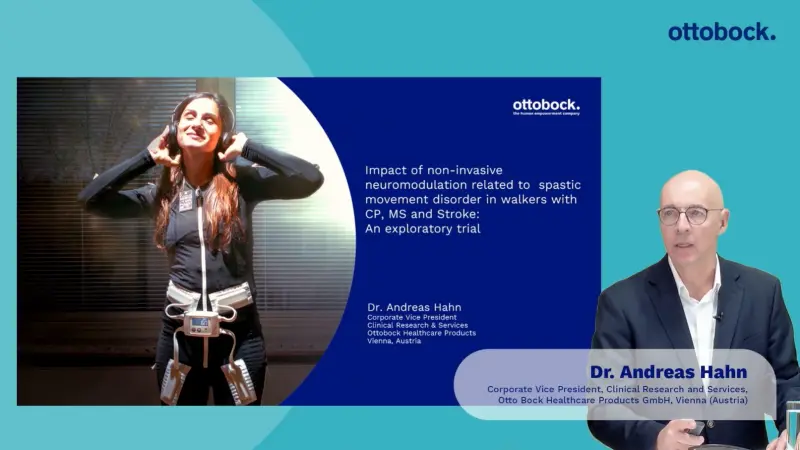Innovative concepts for neuromobility care: How might patients benefit?

Friday, 15 December 2023
A growing number of assistive products are becoming available for people with neurological conditions. Some of these innovative technologies are already generating compelling levels of evidence to support their value, both individually and in combination. In Ottobock’s latest virtual webinar, three experts presented recent findings for two promising clinical applications: early rehabilitation of individuals with spinal cord injury (SCI) using a microprocessor-controlled stance- and swing-phase knee-ankle-foot orthosis (C-Brace®) and management of spastic movement disorder with the latest version of the Exopulse Mollii Suit.
Moderated by Prof. Dr. med. Dipl. oec. Bernhard Greitemann, Medical Director and Chief Orthopedic Surgeon at Münsterland Rehabilitation Hospital in Bad Rothenfelde, the symposium featured Dr. Andreas Hahn, VP of Clinical Research and Services at Ottobock, Dr. Arun Jayaraman, PT, Professor and Executive Director of the Max Näder Center for Rehabilitation Technologies & Outcomes Research at the Shirley Ryan Ability Lab, and Arne Schlausch, Project Manager for Clinical Research and Services at Ottobock. Attendees from around the world logged on to hear these experts discuss the impact of emerging clinical modalities in neuromobility care.
Exopulse Mollii Suit: Swift, significant, sustained improvement in spasticity symptoms
Dr. Hahn opened the discussion with the results of an exploratory trial of the Exopulse Mollii Suit: a near-full-body neurostimulation garment designed to reduce spasticity and related pain with just an hour of wear time. New clinical evidence now shows that this approach can deliver swift, significant, and sustained improvement in both patients’ mobility and pain levels.[1]
The recent Exopulse Mollii Suit study evaluated a total of 44 patients with multiple primary conditions, including cerebral palsy (CP, n=16, 7 pediatric), multiple sclerosis (MS, n=16), and stroke (n=12). All participants were at elevated risk of falls, as measured by the Berg Balance Scale (BBS < 45). Participants were evaluated at three timepoints: baseline (T0), after a single 60-minute stimulation session (T1), and after four weeks of home use (T2).
The results showed:
Significant functional improvement and reduced fall risk in all three cohorts after one hour of stimulation (increased BBS T0→T1).
Sustained improvement with regular use, with all three cohorts demonstrating improved mobility and decreased fall risk after 4 weeks q.o.d. stimulation (increased BBS T1→T2).
Significant reduction in spasticity-related pain after one hour of stimulation (reduction in EQ5D5L pain scores). This improvement was also sustained by regular stimulation.
The study also provided cohort-level evidence for the suit’s impact:
CP, MS, and stroke patients all showed significant and sustained reduction in pain at T0, T1, and T2.
CP patients showed significant improvement in balance and functional gait parameters.
MS patients showed significant improvements in balance, mobility, and quality of life (QoL).
Stroke patients highly benefit from the Exopulse Mollii Suit in terms of balance and QoL.
As Dr. Hahn noted, these results provide encouraging evidence for the Exopulse Mollii Suit’s impact on multiple key clinical parameters, especially fall risk and pain. With positive effects perceptible in just 60 minutes, easy and early identification of responders should make trial fittings even more attractive and effective.
Enhancing rehabilitation potential in patients with SCI
Joining virtually from his clinic in Chicago, Dr. Arun Jayaraman, PT, shared his experience comparing novel and traditional approaches to functional rehabilitation of patients with both complete and incomplete SCI.
Dr. Jayaraman and his team recently conducted a study to evaluate post-inpatient rehabilitation outcomes achieved using two different approaches:
Traditional mobility care for acute SCI with primary wheelchair use combined with locked KAFOs and other standard assistive devices (n=15 patients)
Rehabilitation using C-Brace, a microprocessor-controlled stance- and swing-phase orthosis (n=15 patients).
At baseline, 3, 6, and 12 months, patients’ physiological and neuromuscular improvement was evaluated using a range of mobility, balance, and functional assessments. Compared with patients managed with traditional methods, patients using C-Brace trended toward substantially higher individual and average improvement in several outcomes:
6-minute walk test (6MWT): Increased walking endurance
BBS: Improved standing balance
10-meter walk test (10MWT): Higher average walking speed (m/s)
Functional gait assessment (FGA): Improved balance when walking
At the end of the study period, Dr. Jayaraman noted, patients using C-Brace with the help of an expert PT were able to achieve multiple positive outcomes: well-controlled general and neuropathic pain, active hip control or impeccable body awareness despite sensory loss, and low to moderate spasticity when loading affected limbs. C-Brace patients were also more able to advance their affected limb without scissoring.
Together, these findings indicate that C-Brace has a valuable role to play in unlocking the full rehabilitation potential of patients with traumatic spine injuries.
Combining devices: Exploring the impact of a complementary approach
With both the Exopulse Molli Suit and C-Brace showing impressive clinical benefits, Arne Schlausch discussed a question that naturally arose for Ottobock’s Clinical Research and Services team: will patients benefit from combining both of these efficacious technologies?
To illustrate that possibility, Arne presented a case study of a patient using both C-Brace and the Exopulse Mollii Suit to manage symptoms related to an incomplete SCI. The patient, Sina, had shown several marked improvements following key transitions in her care:
Wheelchair + stance control orthosis → C-Brace: With conventional mobility aids, Sina experiences > 12 falls/week. After switching to a C-Brace, she has regained a natural, nearly physiological gait.
Pharmacological pain control → Exopulse Mollii Suit: Following her injury, Sina relied on a combination of medications to manage pain and spasticity. Since starting regular stimulation with the Exopulse Mollii Suit, she has been able to taper completely off her drug regimen.
While Sina’s experiences are singular, her outcomes are supported by clinical evaluation of her outcomes. In a longitudinal assessment of her outcomes over 4 years, she has achieved multiple meaningful improvements associated with her use of C-Brace, including:
Increased BBS score/reduced risk of falling
98% reduction in falls
Substantial increase in QoL
As Arne noted, experiences like Sina’s may indicate that these two devices deliver a strong synergistic effect: C-Brace can have a positive effect on balance, perception of safety, and QoL, while the Exopulse Mollii Suit provides a complementary, multidimensional effect on both balance and other clinical outcomes like gait speed, bladder control, and medication use. Combining these two innovative technologies may be a valuable approach for patients experiencing physiological and neuromuscular challenges similar to Sina’s.
Looking ahead: New innovations may offer life-changing opportunities
In closing the symposium, Dr. Greitemann noted that each of these three datasets offers compelling support for the use of technologies like C-Brace and the Exopulse Mollii Suit – but that now is the time for clinicians to focus closely on identifying patients with the greatest possibility to benefit from either or both devices. With a combination of convincing evidence and clear selection criteria, these novel technologies may have the potential to make a transformative impact in neuromobility outcomes.
To view the recording of the webinar, please register by clicking on this link. After successful registration, the link to the recording will be sent in the confirmation email.
Source:
[1] Hahn A, Moeller S, Schlausch A, Ekmann M, de Chelle G, Westerlund M, et al. “Effects of a full-body electrostimulation garment application in a cohort of subjects with cerebral palsy, multiple sclerosis and stroke on upper motor neuron syndrome symptoms”, 2023, Biomedical Engineering, doi: 10.1515/bmt-2023-0271

